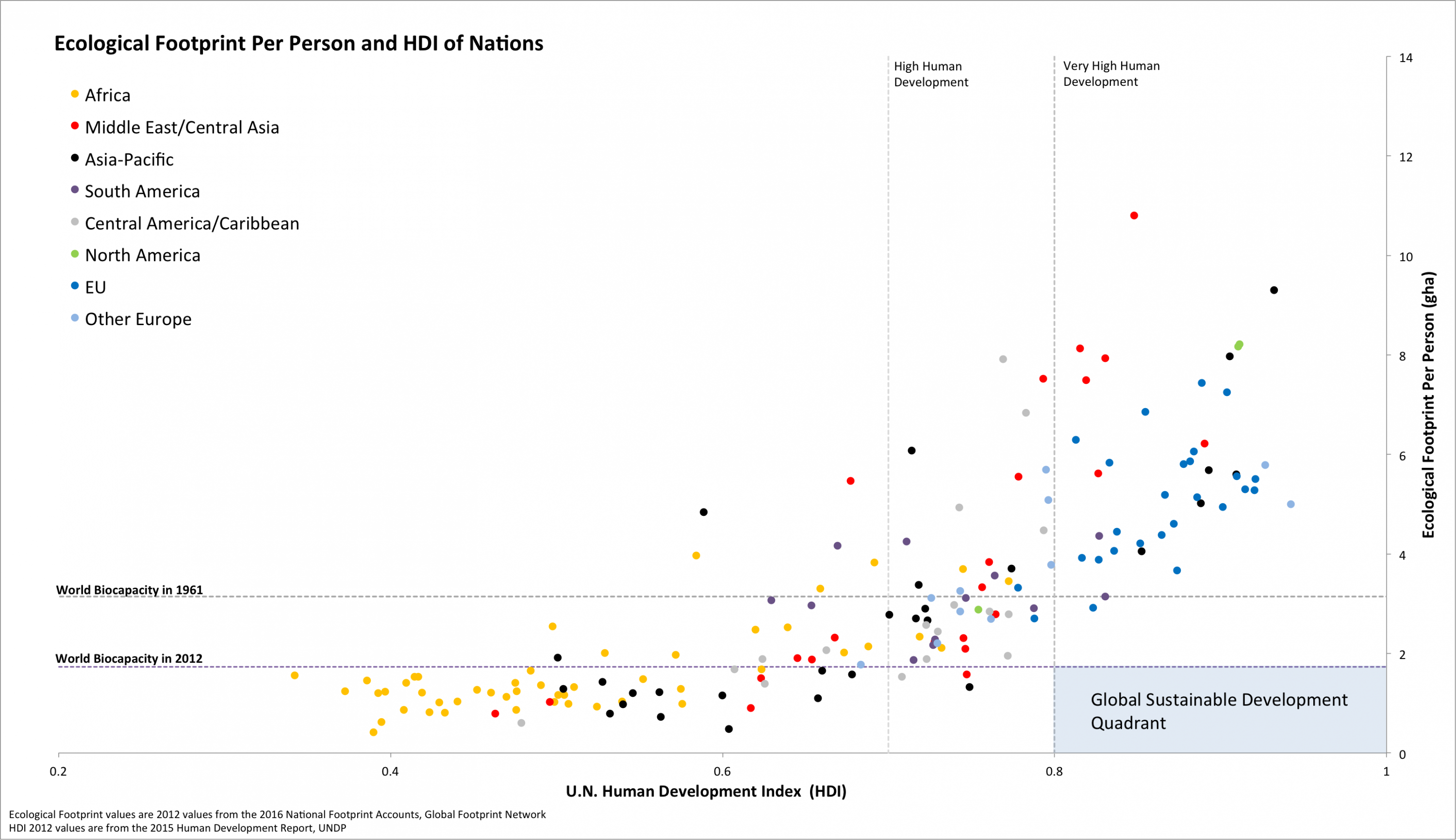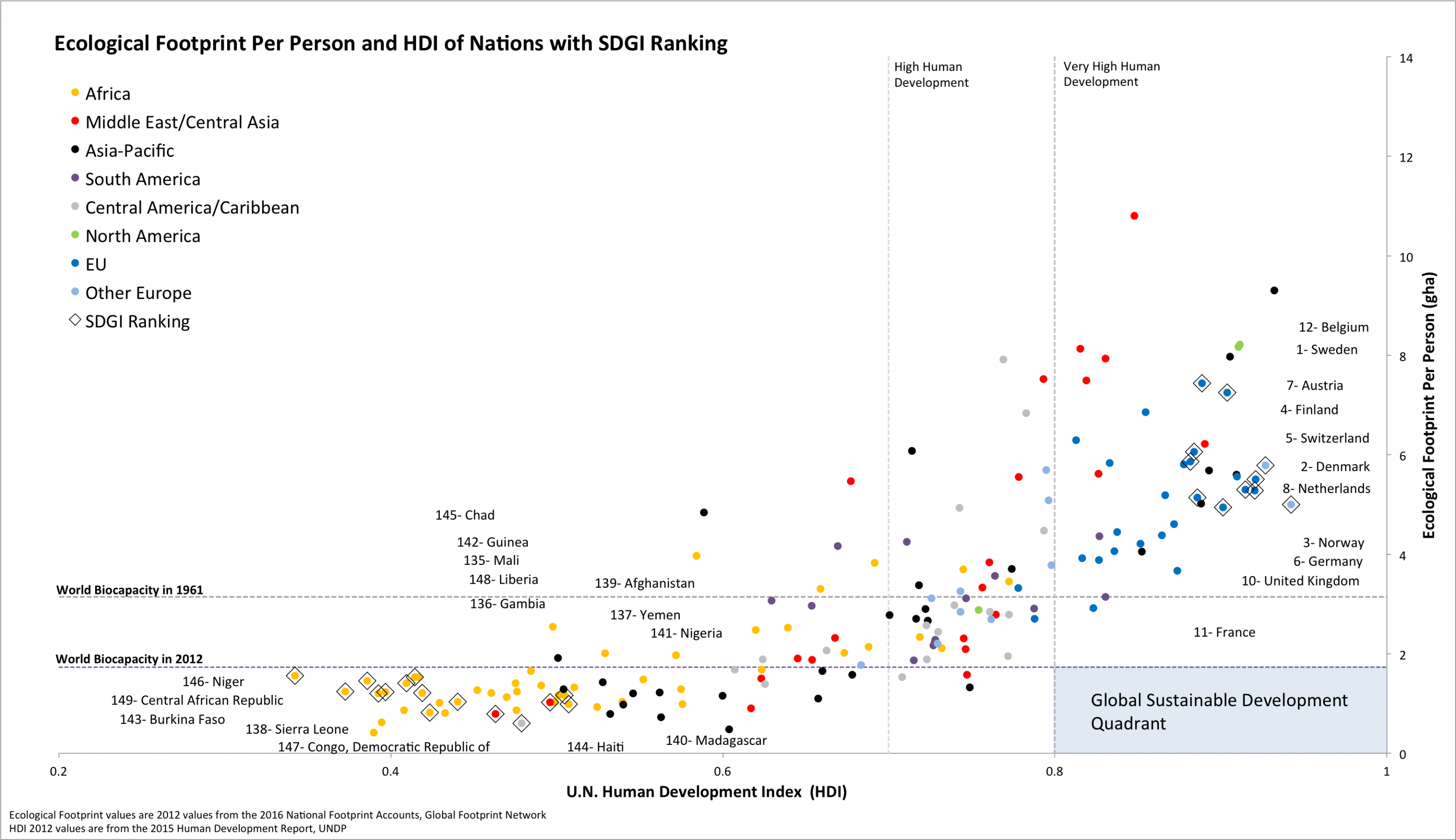The SDG Index reveals that the Sustainable Development Goals are vastly underperforming on sustainability. This may undermine humanity’s progress in development.
Sustainable development has become the North Star for the international community. It is a commitment to everyone’s wellbeing (development), while recognizing the need to operate within the planet’s ecological limits, that is: be sustainable. This is the essence of any serious sustainable development definition, including the one of the World Wildlife Fund (WWF), International Union for Conservation of Nature (IUCN) and United Nations Environment Programme (UNEP). They propose to “improv[e] the quality of human life while living within the carrying capacity of supporting eco-systems.” The Brundtland commission proposes sustainable development as “development that meets the needs of the present without compromising the ability of future generations to meet their own needs.” While the latter does not explicitly reference biophysical constraints, it does so implicitly: a depleted planet will not be able to provide the necessary physical inputs for future generations.
Only 20 Years Left…
The fact that the world’s regenerative capacity is overstretched is hardly disputed, nor that natural capital is becoming a limiting factor for current and future human activities. The Millennium Ecosystem Assessment and research backing the planetary boundaries initiative document severe ecological overuse, including rapid biodiversity loss, excessive nitrification, and climate change.
The limitations imposed by the planetary boundaries have gained more prominence through the 2015 Paris Climate Agreement’s target to not exceed 2°C warming over pre-industrial temperatures (ideally no more than 1.5°C). If we accept this limit, then humanity has no more than 20 years of current CO2 emissions left for the next millennium and beyond, whether from fossil fuel use, cement production, GHG emitting agricultural practices or land-use change.
Climate as one key constraint
The 2015 Paris Climate Agreement’s target to not exceed 2°C warming over pre-industrial temperatures (ideally no more than 1.5°C) was a significant accomplishment. While such warming may not seem like much for the layperson, higher temperatures would with great likelihood reduce the planet’s productivity, increase weather calamities, and also melt land-locked ice that would flood coastal cities. The warming is caused by increasing concentrations of CO2 in the atmosphere. Before industrialization the concentration was 270 parts per million (one million air molecules contained 270 CO2 molecules – or ppm for short). Currently, the atmospheric concentration has already reached 405ppm CO2 in the atmosphere. Many climate models conclude that this concentration may already commit humanity to 1.5°C warming. These models also calculate that 450 ppm CO2e is the upper limit for giving humanity a high probability of staying below 2°C over the long-run – it takes a few decades to fully play out. Note the little “e,” which stands for equivalent, to indicate that this number includes other greenhouse gases as well. (Let’s ignore this complication for simplicity sake, even though most assessments indicate that including other greenhouse gases, the ppm level has already exceeded 450). Current emissions lead to an annual 2-3 ppm increase in the atmospheric CO2 concentration. If we accept 450 ppm CO2 as the limit, then it becomes easy to calculate from these numbers that humanity has no more than 20 years of current CO2 emissions left for the next millennium and beyond. This is less than 700 Gt CO2e. And this includes all: fossil fuel use, cement production, GHG emitting agricultural practices or land-use change.
Humanity has no more than 20 years of current CO2 emissions left for the next millennium and beyond.
 PHOTO CREDIT: PEXELS/ PEXELS.COM
PHOTO CREDIT: PEXELS/ PEXELS.COM
Humanity’s Ecological Footprint and the SDG Index
It is possible to quantify humanity’s current overall overuse of the planet’s ecosystems. One comprehensive metric adds up all of humanity’s competing demands for biologically productive space: area for crops, fish, livestock, fiber, timber, the sequestration of excessive CO2 from fossil fuels, and productive areas used for cities and roads. All of this adds up to humanity’s Ecological Footprint. The latest conservative estimates indicate humanity’s demand exceeds the available capacity by over 60 percent. Such overuse occurs because people can emit more CO2 than the land and the oceans sequester, trees can be cut more quickly than they regrow, and fish can be harvested faster than they restock. As the flows of natural capital demanded by human activities exceed what natural capital regenerates over the same time period, this metric reveals stock depletion leading to environmental degradation.
Given the call for sustainable development and the clearly documented physical constraints, the question becomes whether sustainable development efforts are successful in achieving the overarching goal of wellbeing for all, within the means of nature.
The most significant global effort to comprehensively address sustainable development are the UN’s Sustainable Development Goals (SDGs) launched in September 2015. Developed by UN member nations, and adopted by 190 countries, these 17 goals and their 169 targets identify global development priorities, effectively defining sustainable development through the selected targets. Through those targets, it becomes straightforward to assess how fully a country has met each goal.
Photo Credit: Global Goals
Related article: “CONNECTING SUSTAINABILITY WITH THE SDGS”
In July 2016, researchers, supported by two non-for-profit organizations, the Bertelsmann Stiftung and the Sustainable Development Solutions Network (SDSN), presented results that quantify and rank the SDG achievements of all countries: the SDG Index. This independently produced index scores each country’s achievements regarding each of to the 17 goals, using readily available international indicators.
To evaluate the consistency of the SDGs with sustainable development outcomes, countries’ SDG Index scorings are compared against the countries’ sustainable development outcomes. This outcome is tracked through a diagram that plots countries according to their development achievements (using the UN’s Human Development Index) on the horizontal, and their resource use (using Global Footprint Network’s Ecological Footprint) on the vertical. This is depicted in Figure 1.
Measuring Central Sustainable Development Outcomes
By identifying nations’ position according to their development status and resource demand, countries’ situations can be compared to the necessary conditions for global sustainable development. These two conditions are marked as the global sustainable development quadrant. The first condition is high human development, or a Human Development Index (HDI) over 0.7 for “high (or 0.8 for “very high”) development. The second condition reflects the resources needed to power this development forever. This means a global Ecological Footprint per person smaller than the amount of biocapacity available per person in the world, which is 1.7 global hectares (gha). This is all of the biologically productive land and sea areas divided by the number of people on the planet. This amount is expressed in global hectares, or average hectares with world average productivity, to make these hectares comparable around the world, recognizing the productivity differences of each actual hectare.
Fig 1: Ecological Footprint per person and HDI by country indicate how close each country is to the two basic global sustainable development criteria. One is the ultimate goal: high human development or an HDI over 0.7 for high, and 0.8 for very high development. The other is the ultimate means, i.e., the ability to power this level of development. This means the Footprint does not exceed a demand on nature that all people in the world could achieve, currently less than 1.7 global hectares. A global hectare, used for both measuring Footprints and biocapacity, are biologically productive hectares with world average productivity.
The threshold for the Footprint would need to be even lower in order to also support wild species, for instance 0.85 global hectares per person if we followed Professor E.O. Wilson’s suggestion of leaving half the biocapacity wild.
The diagram in Figure 2 reveals that the countries ranking among the top ten in the SDG Index are far distant from the global sustainable development quadrant in the bottom right; the ten countries with the lowest ranking on the SDG Index have a low Footprint and low HDI and fall at the traditional bottom of development.
This is not a coincidence. To put it in statistical terms, if SDG achievement was uncorrelated with each country’s level of resource demand, we would not see SDG ranking mimicking classical development. In fact, the likelihood of 19 out of the top 20 ranking countries in the SDG index having a high Footprint (over 5 gha per person) would be very low. We calculate it that it would be by chance only with a likelihood of under one tenth of a billionth. (Also note that the “under-5-gha Footprint exception” among the top 20 SDG Index countries is the UK with a Footprint of 4.9 gha per person).
It would take the ecological capacity of over three planet Earths to materially support all of humanity.
To put it another way: Our results show that countries that rank high on the SDG Index have high Ecological Footprints – not just by coincidence. This suggests that the SDG Index gives far higher weight to “development” while underweighting “sustainability.” But without sustainability, development will not be able to persist.
Related article: “CAN DONALD TRUMP REALLY AFFORD TO IGNORE CLIMATE CHANGE?”
Also note that the average Ecological Footprint of the index’s top 20 ranked countries is so large that if all other countries consumed at the same rate, it would take the ecological capacity of over three planet Earths to materially support all of humanity.
This level of demand on the planet is clearly not sustainable.
As a growing population and climate change increase pressure on natural resources, decreasing overall resource demand is crucial for being able to continue to fuel development achievements.
| Country Name of top 20 and bottom 20 countries in SDG Index | SDGI Rank | Ecological Footprint in gha/pers |
| Sweden | 1 | 7.2 |
| Denmark | 2 | 5.5 |
| Norway | 3 | 5.0 |
| Finland | 4 | 5.9 |
| Switzerland | 5 | 5.8 |
| Germany | 6 | 5.3 |
| Austria | 7 | 6.1 |
| Netherlands | 8 | 5.3 |
| Iceland | 9 | 10.0 |
| United Kingdom | 10 | 4.9 |
| France | 11 | 5.1 |
| Belgium | 12 | 7.4 |
| Canada | 13 | 8.2 |
| Ireland | 14 | 5.6 |
| Czech Republic | 15 | 5.2 |
| Luxembourg | 16 | 12.0 |
| Slovenia | 17 | 5.8 |
| Japan | 18 | 5.0 |
| Singapore | 19 | 8.0 |
| Australia | 20 | 9.3 |
| Benin | 130 | 1.4 |
| Malawi | 131 | 0.8 |
| Mauritania | 132 | 2.5 |
| Mozambique | 133 | 0.9 |
| Zambia | 134 | 1.0 |
| Mali | 135 | 1.5 |
| Gambia | 136 | 1.0 |
| Yemen | 137 | 1.0 |
| Sierra Leone | 138 | 1.2 |
| Afghanistan | 139 | 0.8 |
| Madagascar | 140 | 1.0 |
| Nigeria | 141 | 1.2 |
| Guinea | 142 | 1.4 |
| Burkina Faso | 143 | 1.2 |
| Haiti | 144 | 0.6 |
| Chad | 145 | 1.5 |
| Niger | 146 | 1.6 |
| Congo, Democratic Republic of | 147 | 0.8 |
| Liberia | 148 | 1.2 |
| Central African Republic | 149 | 1.2 |
This SDG Index makes it possible to reveal a paradox humanity still needs to overcome: as shown in Figure 1, the SDG Index rankings mimic the conventional development pattern that links higher development achievements with higher Footprints, rather than approaching the global sustainable development quadrant.
This conventional development pattern is exactly what sustainable development endeavours to rectify.
The SDG Index may still be an inadequate representation of the UN’s SDGs. The authors of the index acknowledge in their own report some of the index’s limitations. But even a more complete SDG Index will unlikely change the conclusions: The SDGs give higher weight to development and less weight to the need for sufficient resources to power this level of development.
Why the SDGs Fall Short of Advancing Human Wellbeing and Equity
This near exclusion of resource aspects and marginal treatment of climate change makes the current SDGs fall short of actively advancing human wellbeing without further depleting the very natural capital on which development depends.
As a growing population and climate change increase pressure on natural resources, decreasing overall resource demand is crucial for being able to continue to fuel development achievements. Further, higher demands of some countries reduce opportunities of others to access the necessary resources, exacerbating equity challenges.
Fig 2: This figure builds on Fig 1. It identifies the top ten and bottom ten countries on the SDG Index. What becomes evident is that the top countries on the SDG index coincide with the top end of the “conventional development cloud,” while conversely the same overlap is true for the bottom ten countries on the SDG index. In other words, the SDGs by and large mimic traditional economic development.
Ignoring physical constraints imposed by planetary limits is anti-poor because with fewer resources to go around, the lowest-income people will lack the financial means to shield themselves from resource constraints, whether it is food-price shocks, weather calamities, or energy and water shortages.
All the legitimate and important development gains the SDGs seek to achieve will fall tragically short without the natural capital to power each nation’s economy. If we want to have a future, we cannot build development paths that continue to overuse nature’s resources. SDGs need to robustly embrace the reality of resource constraints and climate change, if we truly are committed to everybody’s ability to thrive.
Recommended reading: “TO FEED THE WORLD IN A CHANGING CLIMATE, AGRICULTURE MUST CHANGE NOW”
EDITOR’S NOTE: THE OPINIONS EXPRESSED HERE BY IMPAKTER.COM COLUMNISTS ARE THEIR OWN, NOT THOSE OF IMPAKTER.COM. This work, including the maintenance of the National Footprint Accounts, was supported by the Barr Foundation and the MAVA Foundation. The researchers of this study have no competing financial interests. FEATURED PHOTO CREDIT: PEXELS
Author contributions: Dr. Mathis Wackernagel drafted the first version. Laurel Hanscom co-conceived the way how to compare the SDG index ranking with the HDI-Footprint approach. All three authors completed the manuscript. Dr. David Lin led the update and improvements of the National Footprint Accounts (2016 edition).
Laurel Hanscom:
Laurel Hanscom is interested in applying meaningful metrics to promote positive change in the world. As Global Footprint Network’s Program Director, she is constantly searching for ways to increase the impact and relevance of Ecological Footprint research, especially through open data and sustainable development projects. She holds a BA and MA in Geography from San Diego State University, where her research focused on climate change vulnerability and agriculture.
David Lin:















